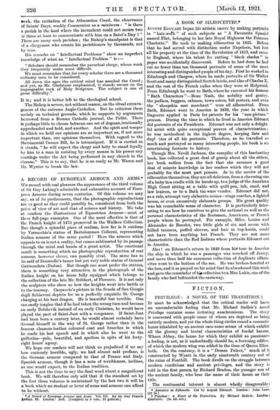A BOOK OF SILHOUETTES.* AUGUST EDOUdET began his artistic career
by making portraits in " hair-work " of such subjects as " A Favourite Spaniel named Flirt, belonging to her late Royal Highness the Princess Charlotte." He took to making silhouettes in 1825. Before that he had served with distinction under Napoleon, but lost all his property at the time of the Revolution of 1813, and came to England, where his talent for cutting " black shades " in paper was accidentally discovered. Before he had done he had cut no fewer than ten thousand portraits of some of the most interesting and distinguished people of his day. First he worked in Edinburgh and Glasgow, where he made ...portraits of Sir Walter Scott and many distinguished Scotch lairds, and also of Charles X. and the rest of the French exiles when they were at Holyrood. From Edinburgh he went to Bath, where he executed his famous " Bath Characters "—Beau Nash, the nobility and gentry, the pedlars, beggars, cabmen, town-criers, bill posters, and even the " sheepskin mat merchant " were all silhouetted. From Bath, Edouart went to America in 1839, the year in which Daguerre applied in Paris for patents for his "sun-picture" process. During the time in which he lived in America Edouart did portraits of six Presidents. Edouart was not only a delight- ful artist with quite exceptional powers of characterization ; he was methodical in the highest degree, keeping lists and dupl sites of all his portraits. Therefore, as he travelled so much and portrayed so many interesting people, his book is an entertaining footnote to history.
Though Mrs. Nevin Jackson, the compiler of this fascinating book, has collected a great deal of gossip about all the sitters, her book suffers from the fact that she assumes a good deal of minute knowledge in her readers which they will not probably for the most part possess. As to the merits of the silhouettes themselves, they are all delicious, from a charming one of a baby in a cradle with its hands up, to a judge of the American High Court sitting at a table with quill-pen, ink, sand, and law lexicon, or to a Bath tin-ware vendor. Edouart did not, as a rule, attempt very elaborate scenes—stage coaches, a lighted house, or even excessively elaborate groups. His great quality was his remarkable sense of character. It is particularly inter- esting to see how he contrives to give the national as well as the personal characteristics of the Scotsmen, Americans, or French people whom he portrayed. For example, Mlles. Louise and Alexandre do Bourlet, two little girls of six and seven with frilled trousers, puffed sleeves, and hair in top-knots, could not have been anything but French. They are not more characteristic than the Red Indians whose portraits Edouart cut in America.
Alas ! on Edouart's return in 1849 from his' tour in America the ship in which he was a passenger was wrecked off Jersey, and more than half his enormous collection of duplicate silhou- ettes went to the bottom of the sea. He was broken-hearted at the loss, and it so preyed on his mind that he abandoned this work and gave the remainder of hip collection to a Miss Lukis, one of the family who had befriended the castaway.


































 Previous page
Previous page